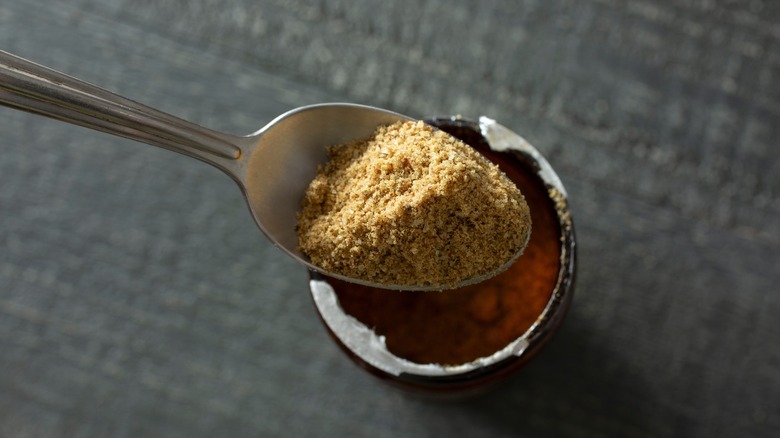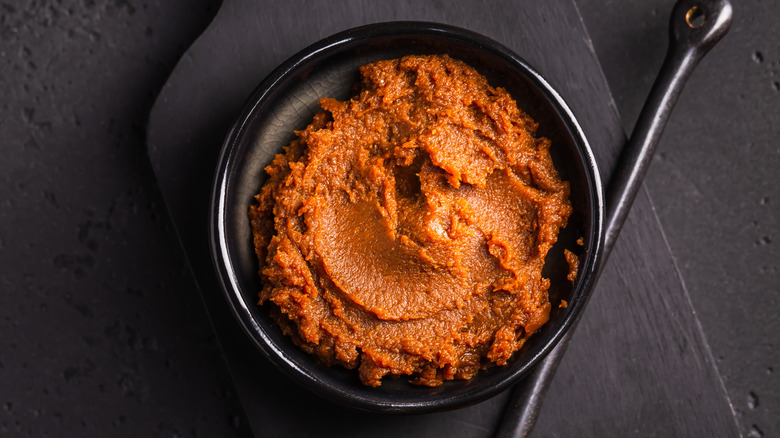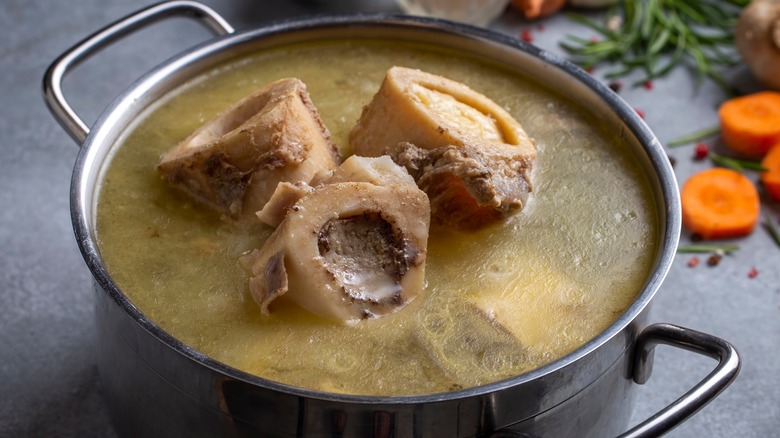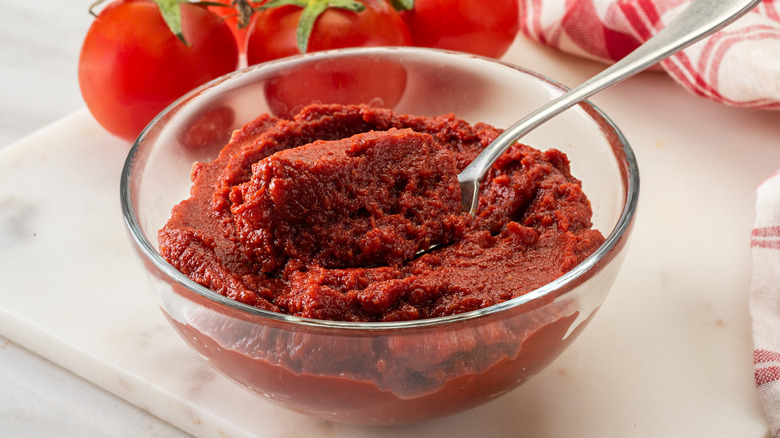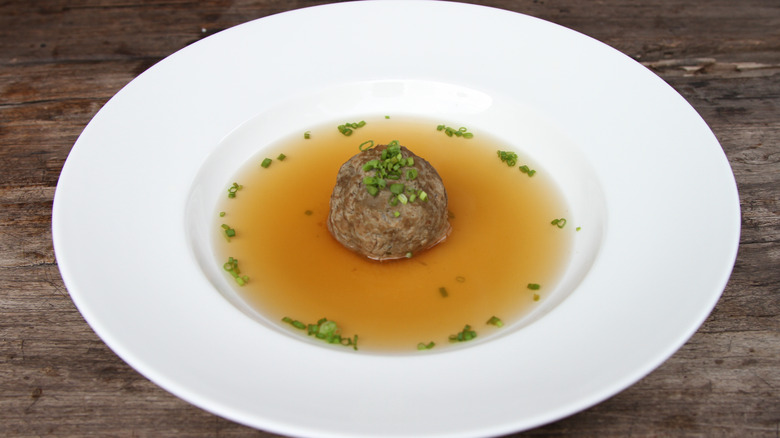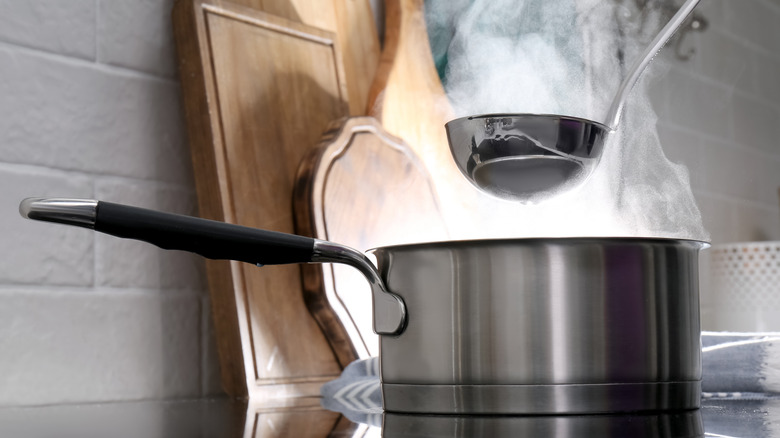16 Best Substitutes For Beef Broth
Beef broth is the perfect base for many soups, it's a great liquid for use with slow cooker recipes to keep meals tender and delicious, and can even add extra flavor to a Bloody Mary. Canned broth can also be stored in the pantry for years provided the can remains undamaged, while homemade beef broth is a frugal alternative that's full of nutrients. But if you're short on beef broth or just want to try something different, there are plenty of substitutions out there that bring the same umami-rich taste to your cooking.
Some alternatives are one-for-one in the recipe while others work in combination with a variety of ingredients. The key to a great substitute for beef broth is to keep in mind the liquid content as well as the rich flavor. If what you use in place of the broth has only one aspect, you may need to add other ingredients as well to keep your dish as delicious as it can be. You can also consider the nutrient content of substitutions and vegetarian-friendly options if you want to avoid meat products.
Beef bouillon
You can whip up your own broth with bouillon, which is concentrated and dehydrated beef broth turned into granules. Simply add the powder to boiling water to transform your base back into broth. This alternative is typically flavored with herbs, spices, and vegetables to give the beef broth an even richer taste, and can be pre-portioned so you know exactly how much to add to certain recipes. Some brands have larger granules while others grind their bouillon into a fine powder. You can experiment with different options to see which you prefer for both taste and texture.
Bouillon is easy to store in the pantry so that you can always have some on hand if needed. It's one of those kitchen essentials that you should try to keep stocked so that even when you run out of broth, you have another go-to option that won't require a lot of changing things up in a recipe. You can also purchase chicken bouillon and use it the same way, although it will have a different flavor than the beef variety.
Chicken broth
If you want fresh broth but can't find beef, you might have more luck if you expand your search to include chicken broth as well. It will bring a slightly different flavor to your dish but can be substituted for beef broth in a pinch. Like the beef version, chicken broth is made from simmering chicken bones and meat in water along with spices and vegetables. You can make your own or opt for store-bought chicken broth in a can, carton, or tub. It can also come in low-sodium options, which is important if you're trying to keep your salt intake down or just want to be able to season your dish yourself.
Chicken broth plays a similar role in soups, stews, and casseroles. It can act as a base for poultry dishes as well as other recipes. Chicken broth doesn't have as strong a taste as its beef-based counterpart, making it a good choice if you want the dish's other flavors to take center stage and the broth to be less intense.
Vegetable broth
Like chicken broth, vegetable broth changes up the taste in dishes but works as a one-for-one sub for beef broth. You can also use vegetable broth to transform meat-rich dishes into vegetarian dupes, although you will likely need to sub out other ingredients as well.
Vegetable broth is made by simmering vegetables, often aromatics like celery, onion, and carrots, in water along with spices to add even more flavor. You can make your own with kitchen scraps, making this a super economical way to get broth that works well in a variety of ways. If you want to give your broth an even richer flavor, roast your vegetables first and then simmer them. Make sure that you strain all of the parts out of the broth since most soften to the point of being mushy and unappetizing.
Of course, you can always go with store-bought vegetable broth, which is found in the same aisle as its chicken and beef alternatives. Keeping a few options in your pantry is a great way to ensure that you're never short on broth when you need it.
Mushrooms
Mushrooms have an umami-rich quality that makes them taste like chicken but also work well in place of beef broth. Sauté them to bring out their earthiness and add them to soups, stews, and casseroles that might be lacking in richness thanks to a shortage of beef broth. You can also use mushroom powder or dried mushrooms, which are carried in most grocery stores and last for months in your pantry.
You'll need to boost the liquid content of your dish in another way, however, so pair mushrooms with added water to keep the consistency the same. You can also make mushroom broth in almost the same way you would vegetable broth. Just simmer mushrooms in water, then strain the result to get a delicious liquid full of rich flavor. You can experiment with different types of mushrooms, including run-of-the-mill white mushrooms, portobellos with a little more flavor, and wild mushrooms that come in all shapes, sizes, and flavors. You can also combine mushroom varieties for a more complex and layered take on the basic mushroom broth.
Stock
No beef broth on hand? Go with stock instead to get an even richer taste, plus added nutrients. Stock and broth have a lot in common since they are both made from simmering beef in water until the flavor is fully infused into the liquid. But while broth includes meat, plus ingredients like spices and vegetables, stock relies mostly on bones. Stock can also include vegetables and spices to add flavor, but it's the bones that really make it stand out, flavor-wise.
Because it's made using bones, stock can be a bit thicker than broth. Gelatin from the bones makes its way into the liquid, which can give the stock a gel-like when it sits at room temperature or in the fridge. If you make your soup or stew with beef stock instead of broth, don't be surprised to see it solidify a bit if you store leftovers. Heating it up will return the stock to a soup consistency. Beef stock is also very high in protein and a good alternative to broth if you want to get more nutrients in each serving.
Beef base
While bouillon is dehydrated powder or granules, beef base is a paste. When combined with water it forms a strong broth. It is often made from roasted beef, plus spices, and can contain stock in its recipe as well. You won't need a lot of beef base when you do use it, which makes this a good ingredient to keep nearby if you find yourself in need of beef broth often. Minor's beef base is one of the most recognizable brands on the shelf.
Beef base can be stored for up to one year and is easy to rehydrate as you cook. Because it has such rich flavor along with a spreadable consistency, it also works as a rub for meat before grilling or roasting, as a marinade, and even as a base for beef gravy. You can change the consistency of your recipe based on how much water you use with the beef base. More water means it will end up with a thinner consistency, which works for soups. But if you keep the base concentrated by adding less water, it's perfect for a thicker gravy or sauce.
Wine
As an option to add flavor to soups and stews, wine can bring in the same hearty element as beef broth. It works best when you add it to dishes that already have beef as an ingredient because it enhances the flavor of the meat. Red wine works with most flavors that pair with beef because it is rich in tannins. These help to tenderize the meat, breaking down tough fibers and releasing plenty of flavor.
Of course, be mindful of how much you add to your cooking because wine is more acidic than beef broth. It doesn't work as a one-to-one substitute, even though it is another liquid. Instead, use chicken or vegetable broth as a base, then incorporate red wine to make the entire dish richer and heartier. When being cooked over heat, alcohol evaporates because it has a lower boiling point than water. However, the exact amount that evaporates varies based on the cooking technique, amount added, and other factors, so you may want to avoid this substitution if you wish not to consume any alcohol.
Soy sauce
If you're short on beef broth but want that burst of umami flavor in your dish, soy sauce might be the key. You can replicate the taste of beef broth with a few dashes of soy sauce, but keep a light hand since it tends to be quite a bit saltier. Consider adding other ingredients, especially spices like parsley and garlic, to work with the soy sauce substitution. This can make the overall dish more complex, which is important especially if you're looking to make these ingredients work as a base.
Many popular brands like Kikkoman also offer low-sodium versions that have the same richness as the original but are noticeably less salty. This allows you to customize the salt level in your cooking and also works to upgrade instant ramen with savory broth rather than plain water. Whether you go with low-sodium or standard soy sauce, start with just a small amount and add more as needed once you taste test.
Miso
Another soy-based substitution is miso paste, which adds a savoryness that beef broth typically brings to dishes. Miso soup is made with miso paste, so it makes sense that this same ingredient works in other soups and stews as well.
Miso also comes in broth form itself and as a concentrate that you can rehydrate to make your own broth at home. Similar to bouillon cubes or granules you just measure out the recommended portion for the amount of broth that you need, mix it into boiling water, and simmer to let the concentrate incorporate fully. You can then add your meat, vegetables, spices, and any other ingredients just like you would in beef broth-based dishes.
If you opt for using miso paste, you may need to experiment with the right measurements and add other liquids to ensure the dish tastes right. Start with a small amount first to see how well it works in the recipe, then add more as needed. Miso tends to be salty, so you might have to temper that saltiness with other aromatics and hearty ingredients, such as vegetables and beef.
Worcestershire sauce
You may struggle to pronounce it, but Worcestershire sauce doesn't have any trouble bringing rich umami flavor to food. Like soy sauce, it should be used in small amounts rather than as a one-for-one substitution for broth. Shake a few dashes of sauce into simmering water, stirring well to incorporate it into the entire mixture. Spices and vegetables are also great additions to round things out.
Worcestershire sauce is made with vinegar and molasses, but the addition of anchovies is what gives this sauce its saltiness. It comes with a bit more tang than you'd get from beef broth thanks to the vinegar. But as long as you use it in small amounts, it can add the same rich flavor. Lea & Perrins was the first commercially available Worcestershire sauce and the brand that turned it into a worldwide food item, but you can find similar options from a variety of brands.
Bone broth
If beef stock works for you, consider going a step further and trying bone broth. It is made with marrow-rich bones, which gives it a deeper flavor than beef broth and even stock. Like stock, it begins to solidify as it cools and ends up with a gel-like consistency at room temperature.
Bones used for bone broth are typically rich in collagen, such as oxtails and ribs, but you can also use others, including chicken and pork. The broth is simmered for a long time to get as many nutrients out of the bones as possible and is often praised for its health benefits as well as its rich flavor.
Making your own requires a lot of simmering, so many people opt to get store-bought bone broth instead. However, making it yourself does allow you to customize the flavor and seasonings, plus it's the secret behind tasty restaurant-quality pho that is hearty and delicious.
Tomato paste
You might be surprised to find acidic tomatoes on this list but the rich, concentrated paste, which can come canned or tubed, can add depth to dishes just like beef broth. You won't need much to do the trick, just add a spoonful of it to simmering water to create a base for soups or stews. If you're working with a casserole where you need to add broth to the dish, mix a small amount of tomato paste with hot water in a separate bowl and measure out what you need for your recipe.
For a more complex flavor, consider adding other substitutions like soy sauce or Worcestershire sauce along with the tomato paste. It may take some trial and error to get the right measurements for your taste buds, but starting with a few dashes of each and taste-testing often is a good way to begin. The soy sauce brings in saltiness like beef broth while the Worcestershire has plenty of umami thanks to its anchovies. Together, these can balance the acidity of the tomato paste while keeping the rich flavor that you need in your base.
Beer
Like wine, beer is a good option that combines liquid content as well as flavor if you need a substitute for beef broth. Beer is less acidic than wine so the taste won't be as jarring, especially when you add it alongside other ingredients like spices and vegetables. You can use beer in place of broth or add it alongside broth to deepen the flavor without changing the consistency of your food.
Experiment with different brews and styles to get varying tastes in your dish. Chef Kwame Onwuachi goes for heavy beers like Guinness to add extra flavor to his dishes, where it both tenderizes the meat and enhances the other ingredients. You can also try lighter brews with brighter flavors, such as pale lagers. These tend to have subtler flavors as well, which keeps your dish from being as heavy as a dark brew. Either way, approach your beer as you would any other ingredient, trying out different variations to get new flavor profiles in your cooking.
Liquid aminos
Liquid aminos is a soy sauce alternative that can also be a great substitute for beef broth. It has a similar umami flavor to bring in the savory element you'd expect from broth, but without as much salt. If you are sticking with a gluten-free diet, liquid aminos is another great ingredient for you to know about.
It can be harder to track down liquid aminos at the store and there tend to be fewer brands available; the Bragg brand is probably the most well-known. Once you do find it, be sure to store it in a cool, dark pantry and then refrigerate it once it is opened.
To use it as a substitute for beef broth, start by adding just a few dashes to your simmering water to see how it tastes. You can always build it up as you incorporate more ingredients, sampling as you go. Like soy sauce, liquid aminos is concentrated and a little can bring in a major flavor punch to your cooking.
Beef consommé
With a similar flavor to beef broth, beef consommé is a perfect one-for-one substitute, especially in soups where its favoring can become the star of the show. It's made by straining beef broth until all of the particles of beef, vegetables, and spices are removed. What's left is tons of flavor in a clear broth. Opting for store-bought consommé makes things easier since you can use it as a base for soups, stews, or other foods without any extra work.
You can also make your own consommé at home, although it adds a step to your recipe preparation. But if you want that smoother flavor without giving up richness, it might be worth the effort. Homemade beef consommé also lets you customize your spices. Most classic French consommé recipes call for mirepoix, a combination of carrots, celery, and onions that are considered essential in this style of cooking.
Water
One of the most important things to consider when substituting ingredients, especially when it comes to broth, is keeping things consistent. You'll need plenty of liquid to make your recipe work without the broth, so water is always one trick to keep up your sleeve. While this is one of the least flavorful alternatives to beef broth, it can still work in a pinch when you need liquid in your cooking. If you find that your soup is too thick, even with the recommended amount of broth, adding water can be a lifesaver as it cooks.
The secret to making water work is to add plenty of other flavorful ingredients, such as aromatic vegetables and spices to boost the taste of your dish. You now know you can throw in a few dashes of Worcestershire sauce, soy sauce, or liquid aminos. Stir in a tablespoon of tomato paste or sprinkle some mushroom powder in the water for depth. Many of the best substitutions on our list rely on water as a liquid base, both to keep the dish from drying out as well as to let the flavors of other additions make their way into the recipe.

